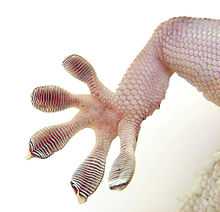Lamella (anatomy)
From Wikipedia, the free encyclopedia

Lamellae on a gecko's foot.
In fish gills there are two types of lamellae, primary and secondary. The primary gill lamellae come out of the interbranchial septum to increase the contact area between the water and the blood capillaries. The secondary gill lamellae are small lamellae that come out of the primary ones and are used to further increase the contact area. Both types of lamellae are used to increase the amount of oxygen intake of the blood. Both types of lamellae contain huge amounts of capillaries and are the sites where the exchange of oxygen from the water and carbon dioxide from the blood occurs.[citation needed]
Lamellae may also refer to the concentric circles (concentric lamellae) around the central Haversian canals in the osteon of the bones. [2]
See also
- Pecten (biology) – the similar structure in birds
References
- ↑ Santos, Daniel; Matthew Spenko, Aaron Parness, Kim Sangbae, Mark Cutkosky (2007). Journal of Adhesion Science and Technology 21 (12-13): 1317–1341 http://www.brill.nl/journal-adhesion-science-and-technology
|url=missing title (help). "Gecko "feet and toes are a hierarchical system of complex structures consisting of lamellae, setae,and spatulae. The distinguishing characteristics of the gecko adhesion system have been described [as] (1) anisotropic attachment, (2) high pulloff force to preload ratio, (3) low detachment force, (4) material independence, (5) self-cleaning, (6) anti-self sticking and (7) non-sticky default state. ... The gecko’s adhesive structures are made from ß-keratin (modulus of elasticity [approx.] 2 GPa). Such a stiff material is not inherently sticky; however, because of the gecko adhesive’s hierarchical nature and extremely small distal features (spatulae are [approx.] 200 nm in size), the gecko’s foot is able to intimately conform to the surface and generate significant attraction using van der Waals forces." - ↑ Marieb, E.N., & Mitchell, S.J. (2012). Human anatomy and physiology laboratory manual. San Francisco, CA: Pearson Education, Inc.
This article is issued from Wikipedia. The text is available under the Creative Commons Attribution/Share Alike; additional terms may apply for the media files.